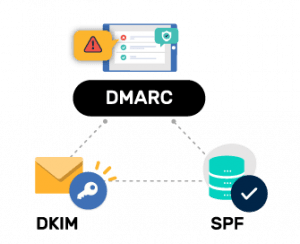What is DMARC? What You Need to Know in 2022
Protecting your business domain takes a lot of resources. You need to prevent the use of your email address by malicious actors. Many of them go out of their way to use your domain to spam inboxes all over the place. This, of course, leaves you in a tough spot, facing a diminished reputation with your site even being blacklisted.
One of the best ways to protect your business presence online is DMARC protocols. You’ll have solid relationships with your partners and vendors by shielding your domain and email infrastructure. Given how cyberattacks have been on the rise since the pandemic hit, it’s essential to know what is DMARC, how it works, and what it can do for you.
DMARC Explained
DMARC is short for “Domain-based Message Authentication, Reporting & Conformance.” It’s a protocol used for authenticating incoming emails that work in conjunction with DKIM and SPF policies to protect your domain, prevent fraudulent use and monitor all activity and traffic. It’s one of the greatest methods to filter phishing and spoofing attacks.
If you wonder what is a DMARC, It’s the succeeding technology for SMTP (Simple Mail Transfer Protocols), which was the first basic protocol used to send emails. This old code doesn’t authenticate emails since it doesn’t have the means to configure the required procedures to perform this task.
On the other hand, is programmed to work with DKIM and SPF. It allows domain owners to establish the policies that all recipients must follow once an email from their website hits their inbox. It also dictates what happens with the message if it fails to be checked by the DMARC policies instructed on your domain’s DNS.
A well-configured DMARC policy also sends detailed reports telling you what happened with all your emails sent. Once you analyze and understand the data provided by these reports, you can improve your authentication protocols, improving your email marketing strategy and increasing trust from your clients, vendors, and partners.
The data also serves to have a good outlook of all emails sent from your domain, allowing you to spot any unauthorized uses. Keep reading to find out more about what is a DMARC record, how it works and how useful is the information provided by this policy for your business growth.

The Base Protocols Serving DMARC
As we take a deep dive into what is a DMARC check, we learn instantly how this protocol relies on two other policies to work correctly. SPF (Sender Policy Framework) and DKIM (DomainKeys Identified Mail) are requisites for your DMARC policy to work like a well-oiled machine. But what are they? What do they do on their own? We have the answers for you.
SPF
The Sender Policy Framework is the first email authentication protocol that needs to be configured for your DMARC policy. Domain owners use this protocol to specify the email servers allowed to send emails on their behalf, thus making it harder for hackers or malicious actors to co-opt their domain and use it for spamming or spoofing.
SPF mail policies are widely used worldwide by most email service providers under regulations emitted by the IETF under the section RFC7028. SPF records are configured as a TXT file inside the DNS used by your business. SPFs work like public listings letting everyone know where your emails are sent. If an email tries to spoof your identity, it won’t match the list, and the receiver’s inbox will take it as a threat.
DKIM
DomainKeys Identified Mail is the second email protocol required to help DMARC work. DKIM policies allow companies and organizations to verify their email flow imprinted with a digital signature. This signature verifies to email providers that your domain has sent the message being received without question.
DKIM policies do a lot for your domain on their own. The protocol helps improve email deliverability and uses asymmetric encryption to generate a set of keys, one public, one private. The public key is published as a TXT record in your DNS, while the private key is used to generate a unique signature for every email sent by your website. These keys prevent your emails from being affected during traffic to be delivered safely.
How does DMARC work
How it’s time to learn what is a DMARC record and how it works. A DMARC record is a line of code included in your DNS that’s custom-built for your website with a specific name. Their usual structure is very similar to this: _dmarc.mydomain.com.
Most DMARC records include a lot of information preceding their structure, such as the version being used, the type of policy being applied, email addresses where reports are sent, and the enforcement policy percentage. There’s no single configuration for DMARC policies. The answer for the question of what is DMARC is different for every company.
The main task of a DMARC policy is to align the messages sent by a website with every piece of data required to pass SPF and DKIM checks successfully. The alignments of all domains on your SPF record should match the encrypted signature included in the headers of your emails. The signature should have a return path tied to your domain.
The alignment is the part that proves tricky for many, but it only requires time and an understanding of each DMARC policy work. There are three different settings: none, reject, and quarantine. They have to be configured on your base domain and any subdomains of your website. Each time you notice failures in your delivery, they have to be adjusted.
DMARC protocol bases itself on SPF and DKIM. When an email fails to check with any of these policies, the message is sent to the spam or junk folder.
Checking Your DMARC Record
Have you ever had a DMARC record check on your company’s website? If you haven’t, it’s high time you do.
To check your DMARC record, you can use EasyDMARC’s Free DMARC Record Checker. If the tool returns Just make sure your site has a DMARC TXT record included in your DNS. You better start looking into DMARC implementation if you get invalid results.
By performing a DMARC lookup, you can ensure your DMARC record is adequately published and deployed on your domain. It’s also a chance to check any underlying mistakes with the syntax of your records and their validation. Remember: a well-enforced DMARC policy lets ISP providers such as Google, Yahoo, and others know you can block malicious emails sent on your behalf successfully.
Understanding DMARC Policies
There are three basic DMARC policies. Each dictates how ISPs handle your emails once they reach their servers. You can configure them accordingly and check the results of your strategy on your DMARC reports. You get to learn what’s working, what is a DMARC failure and how to fix it. This is what each policy does:
None
The none policy is indicated with the tag “p=none,” and it treats your messages as if no DMARC policy had been configured for your website. Emails are sent to inboxes, spam, or discarded. The policy acts very much in line with the behavior of filters set in place by receivers. It favors DMARC analysis for the best since it takes a cue from what works and increases your deliverability.
“p=none” is better than not having DMARC at all, as it lets you monitor your sources.
Quarantine
Quarantine is labeled with the tag “p=quarantine” ; this option grants access to most sources, leaving out the ones that fail the DMARC policy. You’ll be able to see why messages are being rejected with detail on the forensic reports issues by your DMARC policy.
Reject
The final policy is labeled with the tag “p=reject,” and it’s the most robust policy applied to all messages. With full rejection mode in place, no message will reach any inbox if it doesn’t pass the DMARC policy check. This is an ideal policy for most companies, but it takes more time and finetuning.
Everybody should aspire to implement this policy to their sources.
DMARC Reports
All DMARC checks leave traces. These traces are DMARC reports, and they work as the validation of enforcement of your DMARC policy. There are two types of DMARC reports, and they both contain different information:
Failure
Failure reports include copies of every email that fails verification in ARFR format. Failure reports are incredibly detailed, including plenty of Personally Identifiable Information (PII). You can find the email address of every rejected receipt, SPF and DKIM authentication results, delivery time, hosting of the receipt, subject of the email, and more.
Failure reports are handy to indicate all the websites damaging your reputation and any potential threats face. The data obtained from them can help look for issues and strategize solutions. Failure reports are sent in real-time, but we must be careful with the data provided on them since they have a high false-positive rate.
Aggregate
Aggregate reports are presented in XML format; they show data of every email sent through a specific domain. Aggregate reports contain plenty of information about large groups of emails, including the sending source IP, the date the message was sent, and the domain that sent the report.
Aggregate reports include all details about SPF check and authentication, DKIM check and authentication, and the applied policies for these emails (none, quarantine, or rejected). The data of these reports are handled by AI technology. The tech analyzes the information to understand everything related to the authentication of your email campaigns and notice what’s working and what doesn’t.
Why do You Need DMARC
A solidly configured DMARC policy helps every domain you come in contact with. It’s a certifiable way to know that all messages sent from your website are coming from you. You get to prove to your clients how reliable you’re as a sender and your capabilities to send any information they require about your services.
DMARC is not a magical tool that erases all your security concerns, but it plays a significant role in giving you peace of mind that nobody can send emails on your behalf and get away with it.
Large companies often face email spoofing and are blacklisted without noticing until it’s too late. Take some action and get your email defenses up with EasyDMARC! A DMARC check done in time will let you know how you need this strategy.



